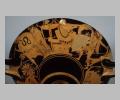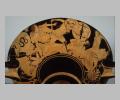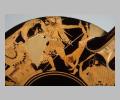| Collection: | Paris, Musée du Louvre |
| Summary: | Interior: Phoenix served with wine by Briseis |
| Ware: | Attic Red Figure |
| Painter: | Attributed to the Brygos Painter |
| Potter: | Signed by Brygos |
| Context: | From Vulci |
| Date: | ca. 480 BC - 475 BC |
| Dimensions: | H. 0.135 m.; Diam. 0.325 m |
| Primary Citation: | |
| Shape: | Cup |
| Beazley Number: | 203900 |
| Region: | Etruria |
| Period: | Late Archaic |
Decoration Description:
Interior: Briseis, Achilles' mistress captured in war (
Sides A and B: Ilioupersis. The scenes on the two exterior sides of the cup, although compositionally self-contained, are linked by a figure of a fallen Trojan, holding his sword up and shielding himself from the attack of a Greek, under one handle. A palmette under the other handle marks beginning and end of the scene.
Side A: On the left, a Greek (labelled Akamas) leads a Trojan female prisoner (labelled Polyxene) away to the left. He wears helmet, chitoniskos, himation, and greaves and carries a spear and shield with snake device. Polyxene is draped in Ionic chiton and himation, wears a stephane and earrings, and has a long pendant lock of hair. In the center of the scene is the altar upon which Priam has taken refuge. The Trojan king sits on the altar, legs splayed, enveloped in Ionic chiton and himation, and holds his arms out in supplication to the Greek Neoptolemos, son of the fallen Achilles. Priam's hair and beard are rendered in added white, and his hair is tied with a fillet painted in added red. Neoptolemos wears the same armor as the other Greeks, and holds a round shield emblazoned with a lion device. His spear falls backwards as he attacks Priam with the corpse of Astyanax, Priam's grandson. The dead boy is shown with blonde hair. Behind the altar is a large tripod with three ring handles.
On Side B, at the left is the Greek attacking the fallen Trojan mentioned above under the handle; he wears a himation and helmet and holds a round shield with snake device. Behind him, a Trojan woman (probably Cassandra) flees to the left. She wears earrings, an Ionic chiton with long kolpos (whose folds are articulated in dilute glaze) tied with an added red belt, and himation, and her blonde hair and blue eyes are rendered in dilute glaze. To her right, a Greek in chitoniskos, cuirass, helmet, and greaves is about to dispatch a fallen Trojan with his sword. The back of the Greek's shield is seen held on his arm, and his scabbard is draped across his torso with an added red strap. The bearded Trojan, with blonde hair and blue eyes in dilute glaze, falls backwards from a wound on his upper arm (blood in added red), his sword slipping from his hand; he wears a himation and scabbard like the Greek's. His body hair is indicated in dilute glaze. At the right end of the scene, a Trojan woman (Andromache, widow of Hector), with blonde hair and blue eyes, in Ionic chiton (the same type as the left woman's) swings a long pestle at the Greek, protecting her son Astyanax who flees to the right. He too has blonde hair and blue eyes and wears a himation and fillet. Astyanax is thus shown twice in the scene, once alive and fleeing, once dead in the hands of Neoptolemos.
While the figures and action are generally similar to those of other contemporary Ilioupersis representations, the names of the combatants are quite different (e.g.
Shape Description: Type B cup
Inscriptions:
On one handle in black glaze
Sources Used:





